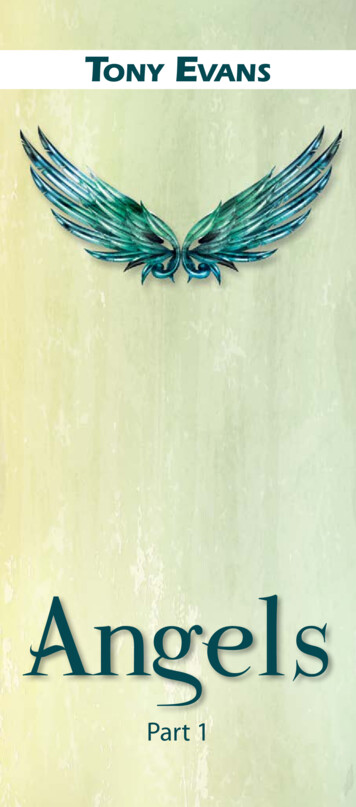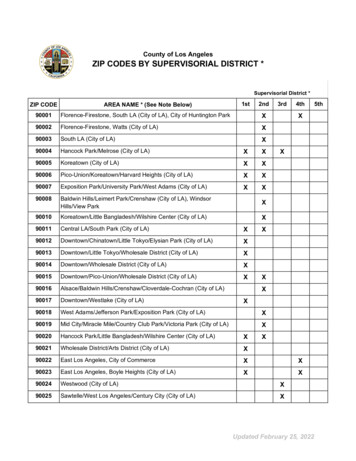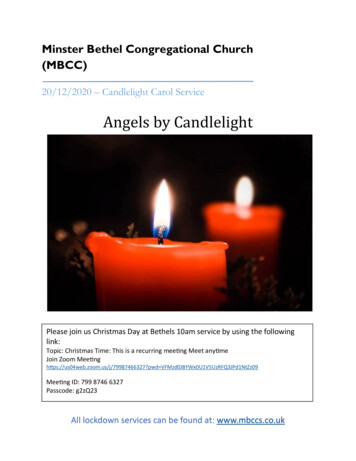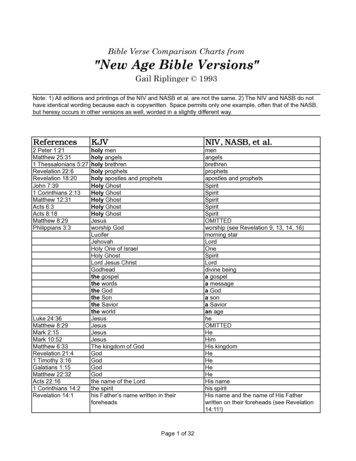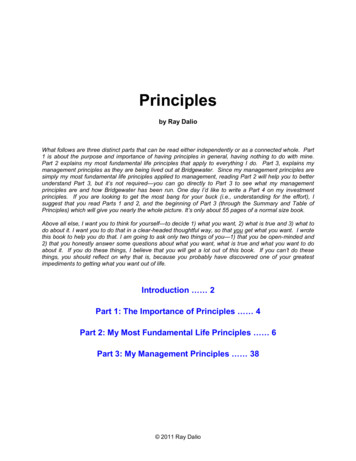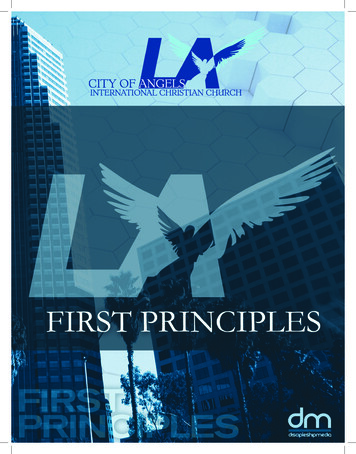
Transcription
First Principlesby Kip McKean“For when by reason of the time you ought to be teachers, you need to have someone teach you the rudimentsof the first principles of the oracles of God Therefore leaving the doctrine of the first principles of Christ, let uspress on to perfection – not laying again a foundation of faith toward God, of the teaching of baptisms, of laying on of hands, of resurrection of the dead and of eternal judgment. This will we do!” Hebrews 5:12; 6:1-3 (WEV)Originally, the First Principle Studies were written in 1980, while I served the Lord during the formative early days of theBoston Church of Christ. They were revised in 2003 and 2006 to meet the needs and to confront the challenges of thePortland International Church of Christ. Recently in 2009, after two years of ministering in Los Angeles, I made a fewmore modifications. As of today, these same First Principles Studies are being taught to all the new disciples of the City ofAngels International Christian Church. God has greatly blessed these lessons as they have been translated into over 20languages around the world. May the Lord con tinue to “solidify, unify and multiply” sold-out disciples everywhere for theevangelization of all the nations in this genera tion! And to God be the glory!Kip McKeanSeptember 1, 2009
IntroductionFIRST PRINCIPLESCourse Information1.This course should take a high priority in your day as it is geared to help you grasp afirmer hold on God’s Word and to deepen your understanding of His will for your life.2.Each session two new Scriptures should be memorized for a written or verbal quiz at thebeginning of each class.3.Each study’s content and order of Scriptures should also be memorized for the quiz.4.Each student is required to memorize the names of all the books of the Bible.5.An outline of the book of Acts will be turned in by session 11. Each student is required tomemorize two points from each chapter in the book of Acts.Outline of ClassesSession 1.Introduction and Seeking GodSession 2.The Word Of GodSession 3.DiscipleshipSession 4.The Coming of the KingdomSession 5.Light and DarknessSession 6.New Testament ConversionSession 7.The CrossSession 8.The Baptism of the Holy SpiritSession 9.The Miraculous Gifts of the Holy SpiritSession 10.The ChurchSession 11.Acts 1 - 8Session 12.Acts 9 - 15Session 13.Acts 16 - 21Session 14.Acts 21 - 28Suggested Reading ListThese books are recommended as thought-provoking and informative tools to be used in gaining insights into God’sWord. In no way are they suggested to be Biblically correct on all doctrinal points.Chapman:Coleman:Edwards:Rivers:Taylor:The Five Love LanguagesThe Master Plan of EvangelismThe Tale of Three KingsVoice in the WindThe Disciplined Life3
IntroductionFIRST PRINCIPLESScripture Memory“But in your hearts set apart Christ as Lord. Always be prepared to give an answer to everyone who asks you to give thereason for the hope that you have. But do this with gentleness and respect.”1 Peter 3:15Session 1Jeremiah 29:11Matthew 6:33Session 2John 8:31-32Philippians 4:13Session 3Mark 1:17John 13:34-35Session 4Acts 2:38Philippians 4:4Session 5Ezekiel 18:20Galatians 1:8Session 6Matthew 22:37-39John 15:8Session 7Matthew 28:18-20Luke 19:10Session 8Hebrews 10:24-251 John 1:9Session 9Hebrews 12:15Hebrews 13:17Introduction to the Course1.Course requirements2.Purpose of First Principles ClassA. Solidify – Hebrews 6:1-3B. Unify – John 13:34-35C. Multiply – Matthew 28:18-203.How to win people to ChristA. Build a good friendshipi. Spend timeii. Have discussionsB. Find out their backgroundi. Life story ( also share yours)ii. Present beliefs about God, Christ and the BibleC. Ask your friend to study the Bible with you.D. Buy a Bible as a gifti. A readable versionii. Inscribe a meaningful thoughtE. If they are an unbeliever about Jesus or if they are unclear about Him then i. Study the book of Johnii. Purpose (John 20:30-31)F. If they believe in Jesus start with the Seeking God Study4.Have a Christian friend you are discipling in on the study as well. Take concise notes for your nonChristian friend, so they can go back and review what has been studied.4
Seeking GodFIRST PRINCIPLESSeeking God1. Psalm 119:1-2A. Blessed means happy (superlatively happy)B. Happiness is not the goal of one who seeks God but the “by-product”C. To seek God you must do it with all your heartD. Seeking God means to “keep His statutes”2. Matthew 6:25-34A. Do not worry – ironic – can not add a single hour to your lifeB. God knows your needsC. Seek first His kingdom and righteousnessD. Then God will give you everything you need3. Acts 17:26-28A. God determines the times and places each person livesB. He does this so men will seek Him, reach out for Him and find HimC. He is not far from anyoneD. A Christian meeting you is not by chance – but of God4. John 4:23-24A. God seeks men (Acts 17 taught men must seek God)B. Men who want to worship Him in spirit and in truth5. Acts 17:10-12A. Read and study the Bible for your own convictionsB. Study daily6. Jeremiah 29:11-14A. God has an individual plan for your lifeB. A plan to prosper you – with hope and a futureC. You will find God when you seek Him with all your heart7. Acts 8:26-39A. The angels and the Holy Spirit are helping to get you to GodB. Do not be afraid to ask questions about life or the Bible – be humbleC. You need someone to explain the Bible to youD. You will be “rejoicing” when you find God8. Matthew 7:7-8A. Seek and God guarantees you will find HimB. Ask God for help5
The Word Of GodFIRST PRINCIPLESThe Word of God1. 2 Timothy 3:16-17A. All Scripture is inspired by GodB. It is to be applied to our lives2. Hebrews 4:12-13A. The Word is relevantB. The Word cuts (hurts)C. Learn that it is good to be “cut,” because a scalpel (God’s Word) “cuts” the cancer (sin) out!3. 2 Peter 1: 20-21A. There is no private interpretation of the BibleB. The Holy Spirit inspired the men who wrote the books of the Bible4. John 8:31-32A. Intellectual belief is not enough – nor can we go by our feelingsB. Everyone must hold on to and follow the teachings of Jesus to be a true discipleC. Sincerity does not equal truthD. Religious people can be wrong5. Matthew 15:1-9A. Do not go by traditions or creedsB. Worship by traditions – which contradicts the Word of God – is worship in vain6. 1 Timothy 4:16A. Watch your life and doctrine closely – they are inseparableB. Which is more important, life or doctrine? Neither – an airplane with only one wing cannot flyC. Why is it so important to learn and to teach and to live the right doctrine? To save yourself and those whohear you.7. Acts 17:10-12A. Must check what religious leaders sayB. Your challenge: Read and study the Bible every day!8. James 1:22-25A. The Word of God is a mirrorB. Do not forget what you see – “do what it says!”9. John 12:48A. Why study the Bible? The Word will judge us!Decision: Will I live by the Bible or by my feelings, traditions, desires, etc.?6
DiscipleshipFIRST PRINCIPLESDiscipleshipIntroduction: Matthew 28:18-20A. What does Jesus want everybody to become?B. Which is the more popular term -“Disciple” or “Christian?” The word “Christian” only appears three times in theNew Testament. It is the name those in the world gave the disciples, seven years after the church began.(Acts 11:19-26) The word “Disciple” occurs over 270 times in the New Testament.C. SAVED CHRISTIAN DISCIPLED. Jesus came to make disciples. Only baptized disciples will be saved.Let’s have Jesus define disciple, thus defining who is a true Christian.1. Mark 1:14-18A. Calling of the first disciplesB. Come follow me (Christ)C. Fishers of men – Jesus gave these first disciples the real purpose for livingD. Immediately2. Luke 9:23-26A. If any man.B. Deny self. Notice Christ in the garden (Matthew 26:36-39, “Not my will, but your will.”) Do notgive in to moods.C. Carry the cross – dailyD. Gain world . forfeit soul. Lose your life for Jesus . save it3. Luke 14:25-33A. If any man.B. Count the cost (v. 28-30)C. Consider the alternatives (v. 31-32)D. Love Christ more than any person (v. 26)E. Persecutions (v. 27)F. Everything, not just anything (v. 33)4. Luke 11:1-4A. Must learn to pray – disciples saw the strength Jesus received from the FatherB. Daily personal relationship with God (v. 3); daily prayer5. John 13:34-35A. Love one anotherB. Be an active part of the fellowship6. Matthew 28:18-20A. Command – make disciples (given to all)B. Who is a candidate for baptism? A person who makes the decision to be a discipleC. You need someone to disciple you to maturity in ChristD. This is the only way to save the ple2488192the world, 5 billion plusConclusion Question: Am I a disciple? Am I a Christian? Am I saved? What do I need to do to become adisciple?7
The Coming of the KingdomFIRST PRINCIPLESThe Coming of the KingdomIn this study you will see the continuity of the Old and New Testaments.Questions:1.What is the Kingdom of God?When did it come?Old Testament Predictions of the Kingdom (The height of Israel’s glory was under the kingship of Davidapproximately 1000 B.C.)A.Isaiah 2:1-4 (750 B.C.)1. Last days2. Mountains (Symbolizes kingdoms): Mountain of the Lord, chief of the mountains3. All Nations4. JerusalemB. Daniel 2:31-45 (550 B.C.)1. Daniel interprets King Nebuchadnezzar’s dream2. Empiresa. Babylonian: goldb. Medo-Persian: silverc. Alexander the Great: bronzed. Roman: iron (iron and clay)3. Rock – cut out not by human hands (therefore God)4. Rock becomes huge mountain – filled the whole earth5. Kingdom that will never be destroyed (v. 44)2.New Testament Predictions of the KingdomA. John the Baptist (25 A.D.)1. Kingdom is near (Matthew 3:1-6)B. Jesus (30 A.D.)1. Kingdom is near (Matthew 4:17)2. Kingdom will come in the lifetime of some of the disciples (Mark 9:1)3. Kingdom will come with power (Mark 9:1)4. Kingdom entered by new birth (John 3:1-7)5. Kingdom is within you (Luke 17:20-21)6. Peter has the keys. (Matthew 16:13-19) Church and the Kingdom are the same and will be built onthe truth that Jesus is the Christ. (1 Corinthians 3:11)7. Joseph of Arimathea was still waiting for the Kingdom when Jesus died. (Luke 23:50-51)8. Repentance and forgiveness of sins will be preached first in Jerusalem to all nations.(Luke 24:44-49)3.Fulfillment of the Old and New Testament Predictions Acts 1-2 (33 A.D.)A.B.C.D.Last days (Acts 2:17)1. Isaiah 2:2All nations (Acts 2:5)1. Isaiah 2:22. Luke 24:47Jerusalem (Acts 2:5)1. Isaiah 2:32. Luke 24:44-49Eternal kingdom (Acts 2:37-42)1. Daniel 2:31-458
The Coming of the KingdomFIRST PRINCIPLESE.F.G.H.I.J.K.Date of coming approximately 33 A.D. (Acts 1-2)1. Old Testament prophecy2. John the Baptist – “is near” (Matthew 3:1-2)3. Jesus – ”is near” (Matthew 4:17)Lifetime (Acts 2:14)1. Mark 9:12. “Some” – Judas died (Acts 1:18-19)Power (Acts 1:8, Acts 2:1-4)1. Mark 9:1New birth (Acts 2:38)1. Water and Spirit (John 3:1-7)Kingdom within (Acts 2:37)1. Luke 17:20-21Peter with the keys (Acts 2:14, 38)1. Matthew 16:19Repentance and forgiveness of sin (Acts 2:38)1. Luke 24:44-494. ConclusionA. The church is the kingdom of God on earth established in approximately 33 A.D.B.Acts 2:42 As citizens of the kingdom and members of the body (the church), we must be devoted to:1. Doctrine2. Fellowship3. Breaking Bread4. PrayerC.Matthew 6:33 We must seek His kingdom first. Ask them to commit themselves to at least SundayServices and Midweek Services.9
Light and DarknessFIRST PRINCIPLESLight and DarknessIntroduction: 1 Peter 2:9-101.DarknessNot a people of GodNo MercyLightPeople of GodMercyLostNot a ChristianNot a DiscipleSavedChristianDiscipleA. Every person is either in the darkness or the light. There is no twilight zone.B. Where are you?DarknessA. Isaiah 59:1-21. Sin separates us from God.WALLDARKNESSMANLIGHTGODSIN2. In order for a man to have a relationship with God the wall must be broken down-sin must beforgiven.3. The point in time sin is forgiven is the point in time a person is saved.B. Romans 3:23-251. Who has sinned? Everyone!SINSINSINPerson A2.3.C.Person BPerson CWho is further away from God, a person who sins a little or a person who sins a lot? All are equal, alllost. Therefore a good moral life does not save you. You cannot earn your salvation by your gooddeeds.Faith in the blood of Jesus saves you. (v. 25)What is Sin?1. Galatians 5:19-21 (sins of commission)2. 2 Timothy 3:1-5 (sins of commission)3. James 4:17 (sins of omission)D. What is the eternal consequence of sin? Romans 6:23WAGES OF SINGIFT OF GODDeathHellDarkness10Eternal LifeHeavenLight
Light and DarknessFIRST PRINCIPLES2.LightA. John 3:1-7 Born again (v. 3), born of water and spirit (v. 5), born again. (v. 7)B. Personal decision as an adultC. What message must one believe to be in the light (to be saved?). Acts 2:22-241. Jesus is from God. (v. 22)2. Jesus raised physically from the dead. (v. 24)3. Everyone is responsible for the crucifixion of Christ. (v. 23) All have sinned. (Romans 3:23)D. Response of people Acts 2:371. Cut to the heart2. What shall we do?E. Once the people believed, what did they do? Acts 2:38-421. Repent (Greek to turn)2. Be baptized (Greek to be immersed).a. Sin forgiven. Therefore this is the point in time a person is saved.b. Holy Spirit given to each who responded-power to live as God commands.F. Baptism Romans 6:1-4Baptism is the sharing (a participation) in the death, burial and resurrection of Christ.(More than just a symbol.)JESUSDIEDRESURRECTEDBURIEDOLD LIFE“DIED WITH CHRIST”“RAISED TO A NEW LIFE”“BURIED WITH CHRIST”DARKNESSSinSeparates us from GodLIGHTActs 2:38Sin is ForgivenBorn Again of Water and SpiritJohn 3:5Acts 2:38Water BaptismSpirit Received at BaptismRomans 3:25Faith in the Blood of Jesus Saves UsJesus shed his blood when he died. In baptism weshare by faith in the death, burial and resurrection ofJesus. Thus we contact the blood in baptism and areforgiven of our sins and SAVED!11
Light and DarknessFIRST PRINCIPLES3.Traditions/False Doctrines – Matthew 15:6-9A. Infant Baptism1. Personal faith is needed. (Colossians 2:12)2. Began approximately third century A.D.3. Original sina. Ezekiel 18:20b. Became “church doctrine” in 549 A.D.B. Praying Jesus into your heart4.1. Revelation 3:20 – taken out of context. This verse is addressed to Christians.2. Began in the early 1800s in America.Sinful natureSuggest to the individual with whom you are studying that he or she write out and be specific about various sinsthey have committed during their life. This is so that they might see the gravity and magnitude of their sin. This isconfidential and should only be shared with those who are studying with the person.12
New Testament ConversionFIRST PRINCIPLESNew Testament Conversion1. The Major Conversions in ActsA. Conversions1. Acts 2:36-472. Acts 8:26-393. Acts 16:22-344. Acts 9:1-22Acts 22:3-165. Acts 18:24-266. Acts 19:1-5First Christian in JerusalemEthiopian EunuchPhilippian jailer and his familyPaulPaulApollosEphesiansB. Questions concerning Conversions1. What was preached?2. What was the person’s (people’s) response to the message?3. How long did the person (people) take to make the decision?4. What was their response after baptism?2.Refuting False DoctrinesA.“Pray Jesus into your heart”: This phrase is never mentioned in the Bible. People may use Revelation3:20 about Jesus knocking at the door, however, you must examine the Scripture in context. This Scripture doesnot teach how to become a Christian and be saved, but how to come back to God after becoming lukewarm. It isaddressed to disciples who already responded to Christ in faith, repentance, confession and baptism.B.“Accept Jesus into your heart:” (Same teaching as praying Jesus into your heart just different terminology.)Based on Romans 10:9. You must look at Scripture in context. Paul is addressing the problem of the Israelites:unbelief that Jesus was the Christ, the Son of God. Read further on to Romans 10:13. When do you call on thename of the Lord? At baptism. (Acts 22:16)C.Infant baptism: A baby cannot have faith, and since we are baptized through faith in the power of God(Colossians 2:12), babies cannot be baptized. Original sin: Ezekiel 18:20 teaches there is no original sin; eachperson is responsible for his own actions and will be judged accordingly. Therefore babies are born sinless andwill be saved if they die.D. “Baptism does not save you:” 1 Peter 3:21 says that baptism does save you through the resurrection of JesusChrist. Acts 2:38 teaches that sin is forgiven at baptism-one is saved at the point sin is forgiven.E. “Baptism is a work-yet we are saved by faith:” (Ephesians 2:8): Colossians 2:12 teaches we are saved byfaith-in the working of God at baptism.F. “Baptism is an outward sign of an inward grace:” Romans 6:2-4 states that baptism is an actual participationin the death, burial and resurrection of Christ. It is not merely a sign, seal or symbol.G.“Baptism isn’t important, after all, look at what Paul said about it in 1 Corinthians 1:17:” Paul does notdiminish the importance of baptism here. (Paul himself was baptized to have his sins forgiven in Acts 22:16.)In context (read 1 Corinthians 1:10-17), he makes the point that he does not want people following men(denominationalism). He mentions baptism several times in the passage.H. “The thief on the cross was not baptized and Jesus told him that they would see each other in paradise:”Jesus had not even died yet, and baptism is participating in his death (Romans 6:2-4); also on earth, he had thepower to forgive sins. (Matthew 9:2-6)I.“Believers baptism:” This is baptism as an adult, but is not done in conjunction with the understanding that oneis being saved at this point in time. (John 3:5, Acts 2:38) “Retroactive understanding” is not sufficient forsalvation.13
The CrossFIRST PRINCIPLESThe Cross1. Passion AccountRead Matthew 26:31 – 28:10Suggested Reading 62-6628:1-102. Physical DeathRead the medical account of Jesus’ physical death.3.Personal ResponsibilityA. Remember there were many others who died by crucifixion in the first century. It was not that Jesus wasphysically crucified that makes Him unique; it was that He was crucified for you, in your place. He died onthe cross for you.B. Romans 3:23C. Isaiah 59:1-2D. Matthew 27:46E. Share the sins that you committed before being baptized and your feelings of being forgiven at baptism.Ask the person with whom you are studying to share and confess their sins.F.Isaiah 53:4-6 (substitute your name).G. If possible immediately after this study watch either The Cross or The Passion video.14
FIRST PRINCIPLESThe Crucifixion: Medical AccountThe Medical Account of the Crucifixion of ChristDr. C. Truman DavisA Physician Analyzes the CrucifixionIn this paper, I shall discuss some of the physical aspects of the passion, or suffering, of Jesus Christ. We shallfollow Him from Gethsemane, through His trial, His scourging, His path along the Via Dolorosa, to His last dyinghours on the cross This led me first to a study of the practice of crucifixion itself; that is, torture and execution by fixation to a cross.Apparently, the first known practice of crucifixion was by the Persians. Alexander and his generals brought it backto the Mediterranean world – to Egypt and to Carthage. The Romans apparently learned the practice from theCarthaginians and (as with almost everything the Romans did) rapidly developed a very high degree of efficiencyand skill at it. A number of Roman authors (Livy, Cicero, Tacitus) comment on crucifixion, and several innovations,modifications, and variations are described in the ancient literature.For instance, the upright portion of the cross (or stipes) could have the cross-arm (or patibulum) attached twoor three feet below its top in what we commonly think of as the Latin cross. The most common form used in ourLord’s day, however, was the Tau cross, shaped like our T. In this cross the patibulum was placed in a notch at thetop of the stipes. There is archeological evidence that it was on this type of cross that Jesus was crucified.Without any historical or Biblical proof, Medieval and Renaissance painters have given us our picture of Christcarrying the entire cross. But the upright post, or stipes, was generally fixed permanently in the ground at the siteof execution and the condemned man was forced to carry the patibulum, weighing about 110 pounds, from theprison to the place of execution.Many of the painters and most of the sculptors of crucifixion, also show the nails through the palms. HistoricalRoman accounts and experimental work have established that the nails were driven between the small bones ofthe wrists (radius and ulna) and not through the palms. Nails driven through the palms will strip out between thefingers when made to support the weight of the human body. The misconception may have come about through amisunderstanding of Jesus’ words to Thomas, “Observe my hands.” Anatomists, both modern and ancient, havealways considered the wrist as part of the hand.A titulus, or small sign, stating the victim’s crime was usually placed on a staff, carried at the front of the procession from the prison, and later nailed to the cross so that it extended above the head. This sign with its staff nailedto the top of the cross would have given it somewhat the characteristic form of the Latin cross.But, of course, the physical passion of the Christ began in Gethsemane. Of the many aspects of this initial suffering, the one of greatest physiological interest is the bloody sweat. It is interesting that St. Luke, the physician,is the only one to mention this. He says, “And being in agony, He prayed the longer. And His sweat became asdrops of blood, trickling down upon the ground.”Every ruse (trick) imaginable has been used by modern scholars to explain away this description, apparentlyunder the mistaken impression that this just doesn’t happen. A great deal of effort could have been saved had thedoubters consulted the medical literature. Though very rare, the phenomenon of Hematidrosis, or bloody sweat, iswell documented. Under great emotional stress of the kind our Lord suffered, tiny capillaries in the sweat glandscan break, thus mixing blood with sweat. This process might well have produced marked weakness and possibleshock.After the arrest in the middle of the night, Jesus was next brought before the Sanhedrin and Caiphus, the HighPriest; it is here that the first physical trauma was inflicted. A soldier struck Jesus across the face for remaining silent when questioned by Caiphus. The palace guards then blind-folded Him and mockingly taunted Him to identifythem as they each passed by, spat upon Him, and struck Him in the face.15
FIRST PRINCIPLESThe Crucifixion: Medical AccountIn the early morning, battered and bruised, dehydrated, and exhausted from a sleepless night, Jesus is takenacross the Praetorium of the Fortress Antonia, the seat of government of the Procurator of Judea, Pontius Pilate.You are, of course, familiar with Pilate’s action in attempting to pass responsibility to Herod Antipas, the Tetrarchof Judea. Jesus apparently suffered no physical mistreatment at the hands of Herod and was returned to Pilate.It was then, in response to the cries of the mob, that Pilate ordered Bar-Abbas released and condemned Jesus toscourging and crucifixion.There is much disagreement among authorities about the unusual scourging as a prelude to crucifixion. Most Roman writers from this period do not associate the two. Many scholars believe that Pilate originally ordered Jesusscourged as his full punishment and that the death sentence by crucifixion came only in response to the taunt bythe mob that the Procurator was not properly defending Caesar against this pretender who allegedly claimed tobe the King of the Jews.Preparations for the scourging were carried out when the Prisoner was stripped of His clothing and His hands tiedto a post above His head. It is doubtful the Romans would have made any attempt to follow the Jewish law in thismatter, but the Jews had an ancient law prohibiting more than forty lashes.The Roman legionnaire steps forward with the flagrum (or flagellum) in his hand. This is a short whip consisting of several heavy, leather thongs with two small balls of lead attached near the ends of each. The heavy whipis brought down with full force again and again across Jesus’ shoulders, back, and legs. At first the thongs cutthrough the skin only. Then, as the blows continue, they cut deeper into the subcutaneous tissues, producing firstan oozing of blood from the capillaries and veins of the skin, and finally spurting arterial bleeding from vessels inthe underlying muscles.The small balls of lead first produce large, deep bruises which are broken open by subsequent blows. Finally theskin of the back is hanging in long ribbons and the entire area is an unrecognizable mass of torn, bleeding tissue.When it is determined by the centurion in charge that the prisoner is near death, the beating is finally stopped.The half-fainting Jesus is then untied and allowed to slump to the stone pavement, wet with His own blood. TheRoman soldiers see a great joke in this provincial Jew claiming to be king. They throw a robe across His shoulders and place a stick in His hand for a scepter. They still need a crown to make their travesty complete. Flexiblebranches covered with long thorns (commonly used in bundles for firewood) are plaited into the shape of a crownand this is pressed into His scalp. Again there is copious bleeding, the scalp being one of the most vascular areasof the body.After mocking Him and striking Him across the face, the soldiers take the stick from His hand and strike Himacross the head, driving the thorns deeper into His scalp. Finally, they tire of their sadistic sport and the robe istorn from His back. Already having adhered to the clots of blood and serum in the wounds, its removal causes excruciating pain just as in the careless removal of a surgical bandage, and almost as though He were again beingwhipped the wounds once more begin to bleed.In deference to Jewish custom, the Romans return His garments. The heavy patibulum of the cross is tied acrossHis shoulders, and the procession of the condemned Christ, two thieves, and the execution detail of Romansoldiers headed by a centurion begins its slow journey along the Via Dolorosa. In spite of His efforts to walk erect,the weight of the heavy wooden beam, together with the shock produced by copious blood loss, is too much. Hestumbles and falls. The rough wood of the beam gouges into the lacerated skin and muscles of the shoulders. Hetries to rise, but human muscles have been pushed beyond their endurance.The centurion, anxious to get on with the crucifixion, selects a stalwart North African onlooker, Simon ofCyrene, to carry the cross. Jesus follows, still bleeding and sweating the cold, clammy sweat of shock,until the 650 yard journey from the fortress Antonia to Golgotha is finally completed.16
FIRST PRINCIPLESThe Crucifixion: Medical AccountJesus is offered wine mixed with myrrh, a mild analgesic mixture. He refuses to drink. Simon is ordered to placethe patibulum on the ground and Jesus quickly thrown backward with His shoulders against the wood. The legionnaire feels for the depression at the front of the wrist. He drives a heavy, square, wrought-iron nail through thewrist and deep into the wood. Quickly, he moves to the other side and repeats the action being careful not to pullthe arms too tightly, but to allow some flexion and movement. The patibulum is then lifted in place at the top of thestipes and the titulus reading “Jesus of Nazareth, King of the Jews” is nailed in place.The left foot is now pressed backward against the right foot, and with both feet extended, toes down, a nail isdriven through the arch of each, leaving the knees moderately flexed. The victim is now crucified. As He slowlysags down with more weight on the nails in the wrists excruciating pain shoots along the fingers and up the armsto explode in the brain. As He pushes Himself upward to avoid this stretching torment, He places His full weighton the nail through His feet. Again there is the searing agony of the nail tearing through the nerves between themetatarsal bones of the feet.At this point, as the arms fatigue, great waves of cramps sweep over the muscles, knotting them in deep, relentless, throbbing pain. With these cramps comes the inability to push Himself upward. Hanging by His arms, thepectoral muscles are paralyzed and the intercostal muscles are unable to act. Air can be drawn into the lungs,but cannot be exhaled. Jesus fights to raise Himself in order to get even one short breath. Finally, carbon dioxidebuilds up in the lungs and in the blood stream and the cramps partially subside. Spasmodically, He is able to pushHimself upward to exhale and bring in
FIRST PRINCIPLES 5 Seeking God Seeking God 1. Psalm 119:1-2 A. Blessed means happy (superlatively happy) B. Happiness is not the goal of one who seeks God but the “by-product” C. To seek God you must do it with all your heart D. Seeking God means to “keep His statutes” 2. Matthew 6:25-34 A. Do not worry – ironic
